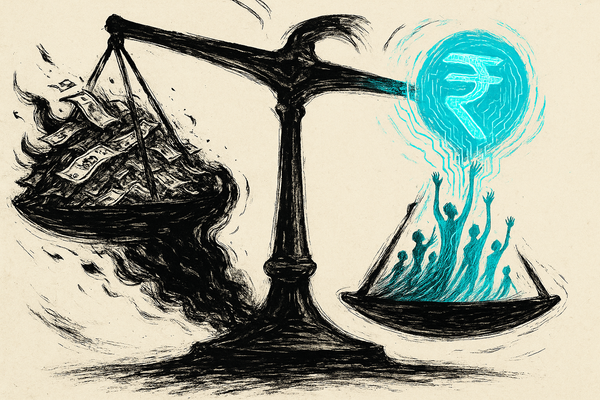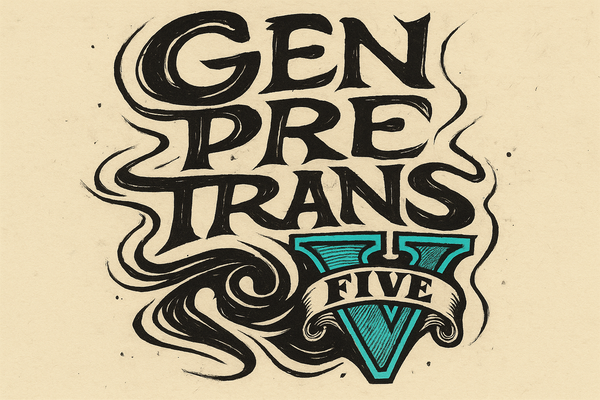ImaginEconomy Daily #16
OpenAI goes open source while everyone fails AI safety. Perplexity buys infrastructure as Shopify embeds commerce everywhere. 20M images generated daily while Google personalizes childhood. The AI wars are over; the infrastructure wars have begun. Control isn't disappearing—it's inverting.

Open Sourcing OpenAI: GPT-OSS Models Finally Arrive
OpenAI has released gpt-oss-120b and gpt-oss-20b, its first open-weight models since GPT-2, under the Apache 2.0 license. The larger model matches OpenAI's o4-mini performance while running on a single H100 GPU, with the smaller 20b model delivering o3-mini capabilities on consumer hardware with just 16GB of memory. Both models use mixture-of-experts architecture, activating only 5.1B and 3.6B parameters per token respectively, enabling efficient deployment at scale.
ImaginEconomy Impact: OpenAI's pivot to open source represents a mature recognition of market dynamics rather than defeat. They've understood what Microsoft learned in the 2000s: sometimes you win by letting go. The Apache 2.0 choice signals serious intent: this isn't grudging compliance but strategic repositioning. By releasing models that match their paid offerings, they're betting that most organizations lack the operational excellence to run these models efficiently. They're probably right. The expertise gap between having access to weights and running production-grade AI at scale in a fully agentic ecosystem remains vast. Smart brands and agencies will recognize this as an opportunity for differentiation: those who master local deployment gain cost advantages AND data sovereignty. The democratization is happening, but the skills chasm and the premium that comes with it is real. OpenAI is fragmenting the market between sophisticated operators who'll run their own infrastructure and everyone else who'll keep paying for convenience. Both segments grow the ecosystem.
Source: OpenAI Introducing GPT-OSS
AI Safety Report Card: When C is the Highest Grade
The Future of Life Institute's 2025 AI Safety Index delivered failing grades across the board, with Anthropic earning the highest score: a dismal C. OpenAI, Google DeepMind, xAI, and Meta all scored D+ or lower, with Meta outright failing the class. Despite explicit ambition and commitment to building AGIs, no company demonstrated adequate strategies for ensuring these systems remain under human control, and all flagship models remain vulnerable to adversarial attacks.
ImaginEconomy Impact: These grades reveal something more nuanced than failure: they document the honest difficulty of the problem. A universal C-or-below isn't indictment but acknowledgment that we're attempting something without precedent: building an alien intelligence while simultaneously trying to understand it. Anthropic's C doesn't make them barely passing; it makes them the only ones seriously attempting the assignment. The vulnerability to adversarial attacks also isn't just negligence but physics: any intelligent and autonomous system complex enough to be useful is complex enough to be unpredictable. For organizations adopting AI, these grades offer clarity: perfect safety is mythology, but thoughtful risk management isn't. The companies scoring poorly aren't reckless; they're simply more honest about uncertainty than those claiming to have solved unsolvable problems. Smart brands will build resilience rather than seeking guarantees. Use AI for its strengths, pattern recognition, content generation, data synthesis, automation to an extent, while maintaining human oversight for decisions that matter. It's not "don't use AI"; it's "don't use it blindly."
Source: Future of Life Institute AI Safety Index
Perplexity Acquires Invisible to Power Agent Infrastructure
Perplexity has acquired Invisible, a multi-agent orchestration platform, to scale its Comet browser and strengthen its AI agent infrastructure. The Invisible team, with backgrounds from Uber and CloudKitchens, brings expertise in building scalable automation APIs and agent coordination systems designed to enable AI agents to operate reliably at enterprise scale.
ImaginEconomy Impact: This acquisition reveals the next phase of AI evolution: from single models to coordinated systems. Perplexity understands what most miss: the future isn't one superintelligent AI but thousands of specialized ones working in concert. Value won't come from one model, but from ecosystem, coordination and automation that delivers a fitting solution. Invisible's Uber DNA brings something crucial to the table: experience building systems that remain stable while millions of chaotic actors interact. This is exactly what multi-agent orchestration requires. The brilliance here is recognizing that sophisticated infrastructure beats raw intelligence. A perfectly orchestrated system of good-enough agents can outperform a brilliant but isolated model that lacks context. For businesses, this signals where real value creation will happen: not in marginally better models but in radically better coordination. Perplexity is building the conductor's platform, and that's a position worth owning.
Source: Invisible × Perplexity Announcement
Shopify Goes All-In on Agentic Commerce
Shopify launched three developer tools: Shopify Catalog, Universal Cart, and Checkout Kit, enabling AI agents to embed commerce functionality directly into conversations. The tools let developers search millions of merchant products in real-time, maintain shopping carts across multiple merchants, and complete purchases without leaving the AI interface, all while handling compliance and payment processing automatically.
ImaginEconomy Impact: Shopify has executed the platform play perfectly: become so essential that competition becomes irrelevant. By turning commerce into portable infrastructure, they're acknowledging that the future of shopping won't happen in stores or even on websites but wherever conversations occur. The Universal Cart solving multi-merchant checkout is genuinely innovative; a shopping equivalent of universal healthcare, removing friction that nobody realized was artificial. This can position Shopify as the TCP/IP of commerce: invisible, essential, and collecting micropayments on much of global economic activity. For merchants, this is liberation from the tyranny of discovery. Your products can now appear wherever relevance exists. For competitors, it's checkmate played three moves ahead. Amazon aggregates supply; Shopify distributes demand. The latter scales even better because conversations are infinite while warehouses aren't. Smart brands will build for this ambient commerce future where every conversation is potentially transactional.
Source: Shopify Agentic Commerce Documentation
Grok's Viral Velocity: 20 Million Images in 24 Hours
Elon Musk announced that xAI's Grok Imagine generated over 20 million images in a single day, up from 14 million the previous day, as the AI video generator rolls out to all X Premium users on iOS and Android. The tool produces 15-second clips with native sound in seconds, claiming 2-4x faster generation than competitors need for single images.
ImaginEconomy Impact: Musk's velocity obsession has accidentally created something profound: a real-time cultural mirror. Twenty million daily images isn't just volume; it's the visual unconscious of the internet manifested. Grok's quality limitations matter less than its speed advantage because culture moves faster than craft. By the time Midjourney generates a perfect image, the moment has passed. Grok captures zeitgeist in real-time, trading fidelity for immediacy. This speed-first approach reflects a deeper truth about AI adoption: most use cases need "good enough now" rather than "perfect later." For brands, Grok represents both threat and opportunity. The threat: your carefully crafted visual identity can suffer from the demand of immediacy. The opportunity: truly real-time cultural response becomes possible. Campaigns can evolve at the speed of conversation. The brands that thrive will be those that know if, why and how to embrace this tempo, using AI's velocity to stay culturally current rather than visually perfect.
Source: Elon Musk on X
Google's Gemini Storybook: AI as a Bedtime Narrator
Google launched Storybook within Gemini, enabling users to create personalized 10-page illustrated stories with audio narration from text prompts or uploaded photos. Supporting over 45 languages and multiple art styles from pixel art to claymation, the feature transforms family photos, children's drawings, or simple ideas into complete narrated books that can be shared or printed.
ImaginEconomy Impact: Google has democratized something previously scarce: everyday creativity manifested in personalized narrative. This isn't replacing human creativity but amplifying parental imagination. The parent who struggles to invent bedtime stories can now collaborate with AI to create something their child genuinely treasures. The 45-language support solves a real problem: immigrant parents can create stories in their native language while their children learn heritage through compelling narrative. The multiple art styles acknowledge that one size doesn't fit all. Critics worry about homogenized childhood, but they're missing the point: these tools don't replace the stories grandparents tell but supplement and even amplify them. They give creative agency to those who thought they had none. For brands understanding future consumers, this matters. Children raised on personalized narratives won't just prefer customization; they'll experience generic content as fundamentally broken. The skill won't be personalization but finding the universal within the personal.
Source: Google Gemini Storybook Blog
Bottom Line: The Infrastructure Inversion
This week's developments reveal an industry maturing from revolution to evolution. OpenAI's open-source release, Perplexity's infrastructure acquisition, and Shopify's embedded commerce all point toward the same insight: the barbaric AI battles of yore are maturing into sophisticated geopolitics of infrastructure.
The failing safety grades aren't cause for despair but clarity. They acknowledge what serious technologists have always known: complex systems are inherently unpredictable. The question isn't whether AI is safe but whether it's useful enough to justify its risks, and how to manage the risks.
The winners won't be AI pessimists paralyzed by risk or optimists blind to challenges. They'll be pragmatists who understand that transformative technologies are always messy, dangerous, and ultimately worthwhile. The internet also broke things that needed breaking and built things we didn't imagine needing.
For organizations navigating this transition, the message is: engage thoughtfully but engage fully. The risks of adoption pale against the risks of abstention. Build with awareness of AI's limitations while leveraging its genuine capabilities. Most importantly, invest in the infrastructure and expertise to use these tools masterfully rather than marginally.
ImaginEconomy Daily Newsletter is curated for brand, business and marketing strategists, creatives, and leaders navigating the intersection of technology and human experience.




